Evolution of China Fashion Chinese Clothes in the 1900s
What comes to heed when you think of traditional Chinese wearable? In this article, nosotros are going to explore the different styles of clothing that have existed throughout each of China's major dynasties, the traditional dress of Mainland china's ethnic minorities, and the part of traditional Chinese habiliment in modern Communist china.
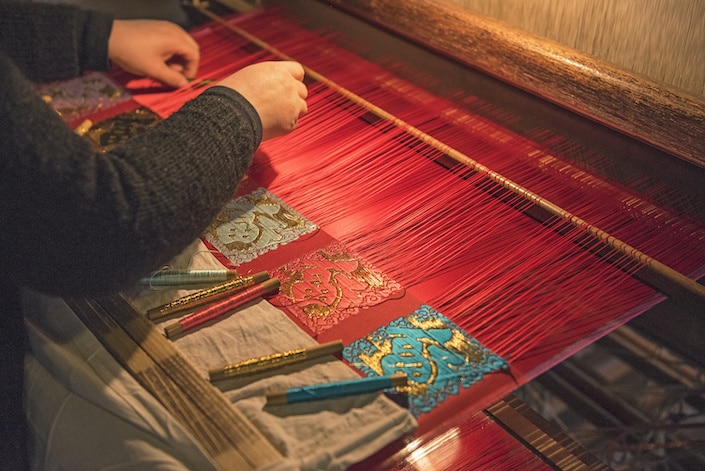
Tabular array of Contents
- Clothing throughout the major dynasties
- Han dynasty
- Tang dynasty
- Ming dynasty
- Qing dynasty
- Traditional vesture of other ethnic minorities
- Dai ethnic minority (傣族 Dǎizú)
- Tibetan ethnic minority (藏族 Zàngzú)
- Uyghur indigenous minority (维吾尔族 Wéiwú'ěrzú)
- Zhuang ethnic minority (壮族 Zhuàngzú)
- Traditional wearing apparel in modern Prc
- A source of pride and cultural recognition
- Formal occasions
- Haute Couture
- The new face of Chinese way?
- Traditional Chinese clothing vocabulary
Clothing throughout the major dynasties
Mainland china notoriously has a long history replete with various different dynasties, each special and influential in their own style. However, there are a few that actually stand up out when it comes to the development of traditional Chinese clothing.
$31.99 ![]()
Traditional Chinese Qipao 旗袍 clothes for women. Cute pattern keen for any formal occasion or night on the town.
Purchase from Amazon
We earn a commission if you make a purchase, at no additional price to you. 12/nineteen/2021 17:54 pm EST.
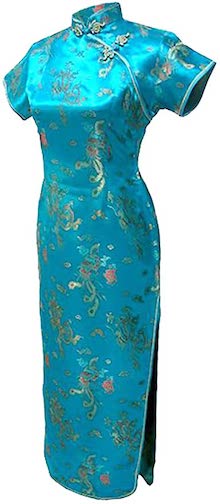
Han dynasty
The Han dynasty (206 BCE-220 CE) was Mainland china's second imperial dynasty and was an age of economical prosperity. It is regarded every bit one of the most powerful and influential dynasties in Chinese history.
Even today when people think of the Chinese, they ordinarily recollect of the Han people. The Han (汉族 hànzú) are the dominant indigenous group in China, and consequently Chinese characters are referred to every bit Han characters (汉字 hànzì). Likewise, the Mandarin linguistic communication is called the Han language (汉语 hànyǔ) and traditional Chinese clothing is called Han article of clothing (汉服 hànfú).
During the Han dynasty, clothing designs and styles were more or less the same for men and women. To distinguish between the genders, dissimilar colors, fabrics and ornaments were used. This era was known for its "dark style," which utilized black and ruby colored fabrics.
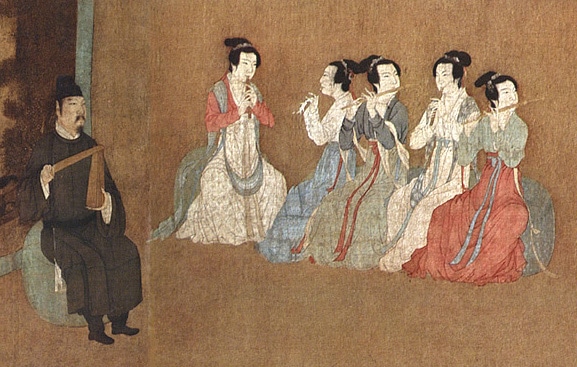
Traditional Chinese clothing, called Hanfu, dates all the way back to the Han dynasty.
Characteristics of Han habiliment include very wide sleeves and a loose layered look, with clothes commonly consisting of two or three garments, mainly a loose open cross-neckband garment, a long wrap brim and an open cross-collar robe used equally the outer garment and wrapped around the waist.
In that location were two main types of robes: the curved hem robe (曲裾袍 qūjūpáo) and the straight hem robe (直裾袍 zhíjūpáo). Women also had the boosted option of wearing a 襦裙 (rúqún) – a cross-collar wrap shirt paired with a long skirt.
Tang dynasty
The Tang dynasty (618-907 CE) is commonly regarded as one of the about prosperous and culturally significant times in Chinese history. Thanks to booming international trade with neighbouring countries via the Silk Road, Indian, Persian and even western culture was integrated into Chinese culture.
Every bit more than fabrics and new dyes were introduced from neighbouring countries, the perfect opportunity was created to facilitate a change in traditional fashion.
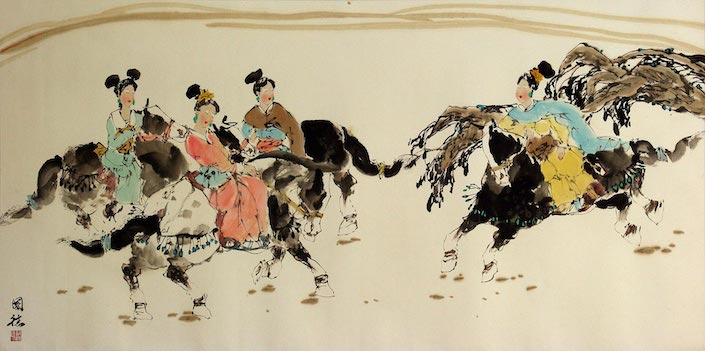
Tang dynasty fashions reflected the prosperous, cosmopolitan nature of the era.
Tang fashions were very colorful, and people put a lot of thought into their outfits. The main materials used were wool, linen and silk, with the latter signifying high status. Silk was exclusively reserved for the noble class due to its price.
Gold and yellow were the exclusive colors of the emperor and imperial family, and gradually evolved into symbols of purple power. Other colors could be freely used by all social classes.
In general, women often wore long sleeved shirts with wide sleeves and collars that showed their cleavage. These shirts, which were considered quite revealing and daring in comparison to previous dynastic fashion trends, were tucked into long flowing skirts decorated with geometric patterns and secured by a sash tied around the breast.
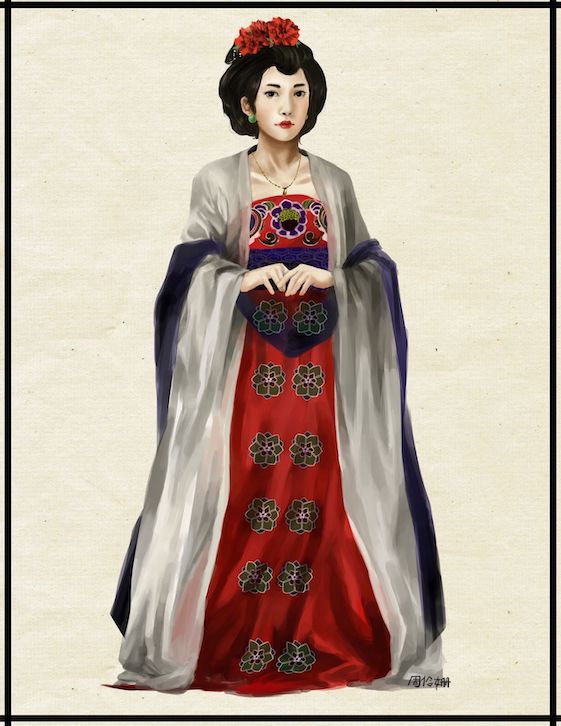
Independent Tang dynasty women wore clothing that was considered revealing and daring at the fourth dimension.
Makeup during this era was also quite daring, with drawn-on eyebrows, lead face pulverisation to create the illusion of very white skin, and bloom-like patterns painted between the brows.
Men's clothing was a continuation of the styles seen in the Han dynasty, just with more options. Daily outfits consisted of solid-colored robes with rounded collars, commonly accompanied with leather belts and boots.
Ming dynasty
Throughout Red china'south dynastic history, at that place were periods where some parts or fifty-fifty all of regal Prc were ruled past non‐Han peoples, mainly from Manchuria or Mongolia. The Ming dynasty (1368-1644 CE) was a Han ethnic majority regime that immediately followed the Mongol-led Yuan dynasty.
The start of the Ming dynasty represented a restoration of Han control, so ane major aim of the Ming ruling class was to promote Han culture and enhance the Han people's sense of identity within the new regime. Therefore, clothing styles closely resembled that which were seen in the Han dynasty, admitting with a twist – removing the influence of foreigners and ethnic minorities.
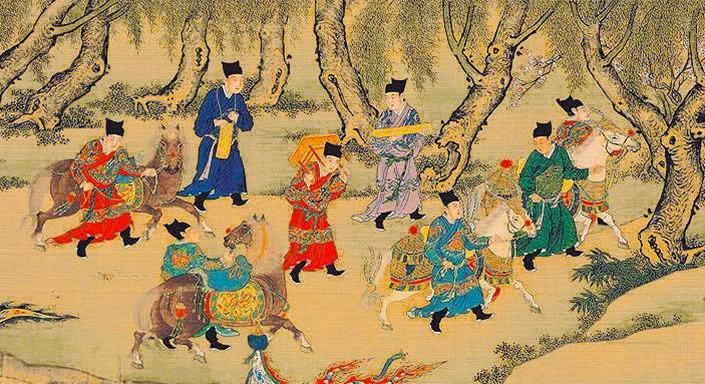
Ming dynasty fashions were similar to those of the Han.
Men's fashion revolved around foursquare collars and patterns which were used to distinguish betwixt social grade and rank. Such patterns or "markings" consisted mainly of embroidered designs featuring animals, plants, and geometric patterns.
Men typically wore their hair in a bun and officials wore a futou (襆头 fútóu), which was a black hat with ii wing-like flaps made of sparse, oval shaped boards on each side.
Women's clothing became more than small-scale during the Ming. About women wore a midi length upper garment over a floor-length skirt. This ensemble helped create the illusion of an elongated silhouette.
Another type of mode was the (袄裙 ǎoqún), a pleated skirt paired with a cantankerous-collar cotton summit that extended downward beneath the waist. Lite and pastel colors were extremely popular.
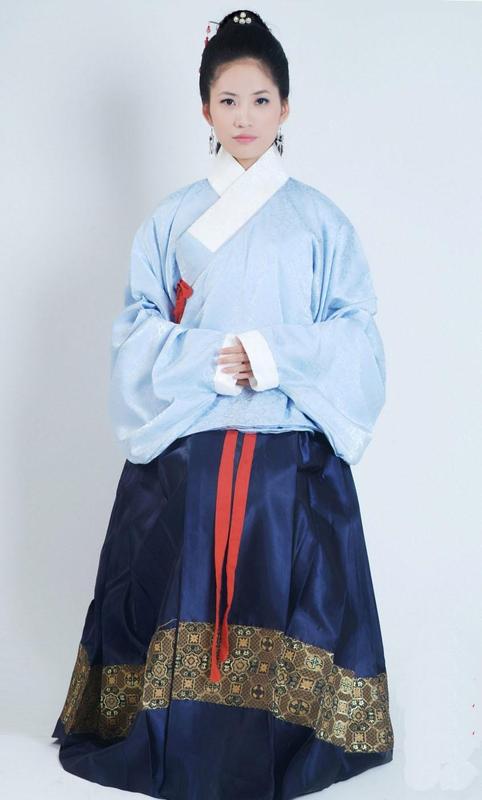
Women'due south fashions during the Ming were more pocket-size and frequently featured pastel colors and cross-neckband tops.
Embroidered capes also became part of the ensemble for both men and women'due south article of clothing. Normally, these capes had a direct neckband with open sleeves.

Qing dynasty
In the 17th century, the nomadic Manchu people overthrew China's Ming dynasty and established in its place the Qing dynasty (1636-1912 CE).
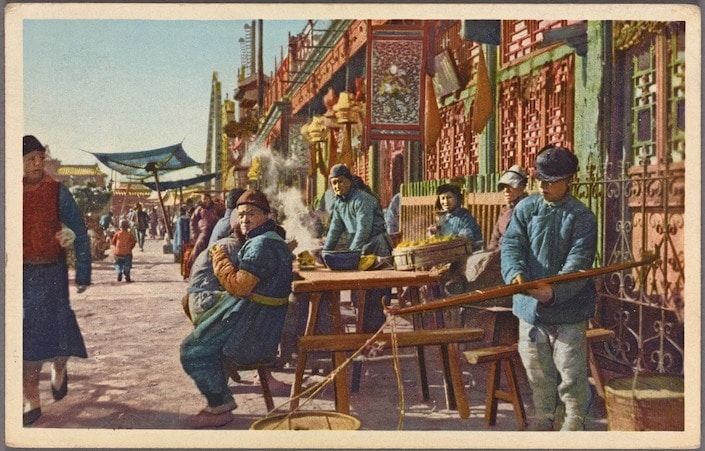
The Qing dynasty was ruled by the Manchus, a non-Han ethnic grouping whose traditional clothing preferences shaped fashion trends during this catamenia.
The Qing dynasty clothing system was extremely complicated and came with a lot of different rules and regulations. During this dynasty, a robe easily revealed the wearer's rank. The dynasty's colour was yellow, and this cheering color was reserved but for the royal family.
Qing dynasty fashion was largely influenced by the cavalry clothing of the Manchu horsemen.
Men typically wore a tangzhuang (唐裝 tángzhuāng), a kind of jacket with a straight collar inspired by the original three-quarter-length riding jackets of the Manchu horsemen. This was commonly paired with an ankle-length wrap skirt. Manchu men also shaved the front part of their hair, leaving the rest in a braid that hung behind their heads (called a queue).
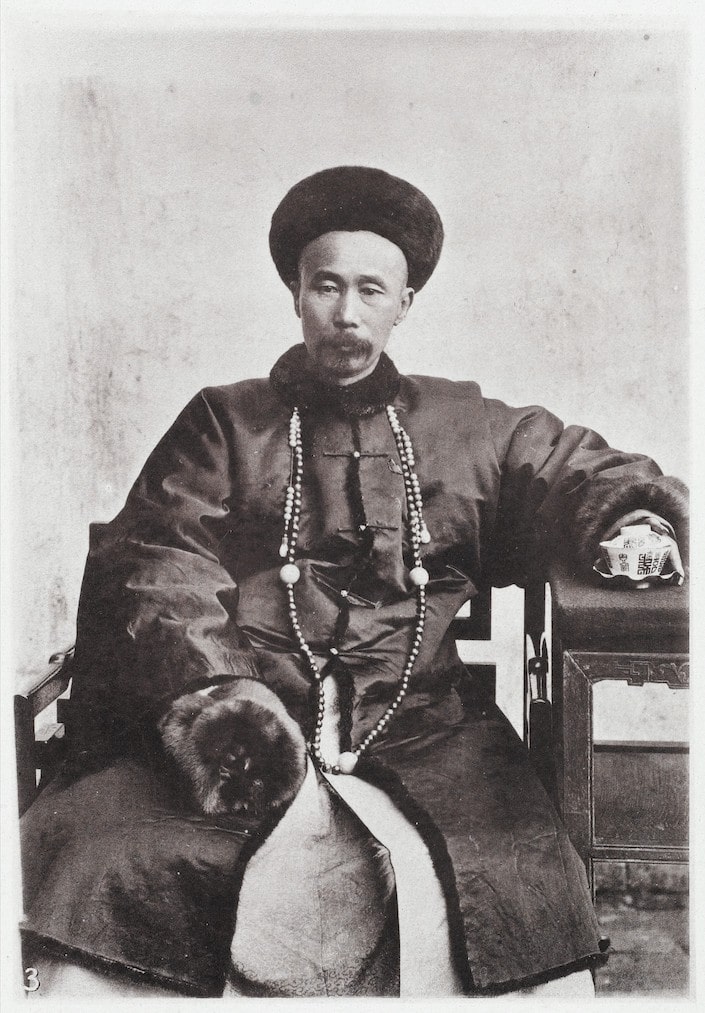
Qing dynasty officials, similar Li Hung-chang (pictured here), wore wear influenced by their Manchu ancestors.
Initially, the Qing dynasty was extremely draconian when it came to wear rules, and many Han Chinese were forced to either adopt the Manchu male hairstyle and habiliment or face the expiry penalty. Withal, this later became a rule applicable simply for those who served as officials or scholars, and non ordinary people.
Manchu women traditionally grew their hair long in training for marriage, and married women had a broad variety of hairstyles to choose from – the most common one being the Liangbatou (两把头 liǎngbǎtóu), which was the hairstyle adopted by Empress Dowager Cixi. This manner consisted of a tall headdress that had ii handfuls of hair parted to each side of the head and decorated with flowers and ornaments.
Dissimilar the men, Han women were immune to vesture the Han-mode habiliment from the Ming dynasty and did non need to wear the traditional Manchu hairstyle for women. The everyday article of clothing way for women from wealthier families consisted of a side or front-fastening robe with a wrap-around pleated frock skirt.
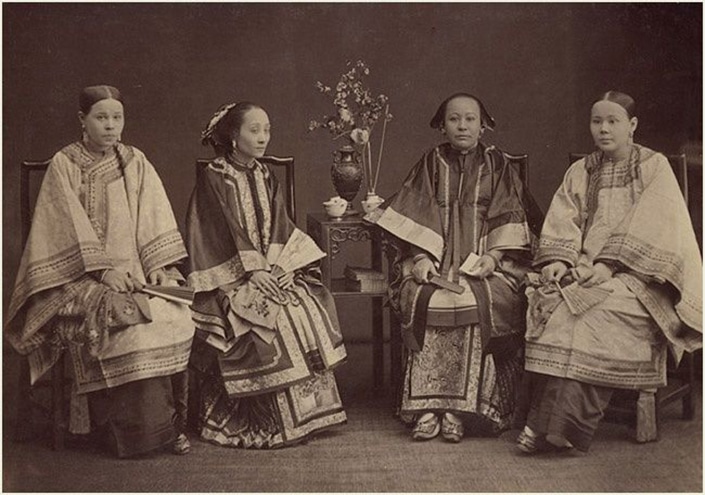
During the Qing dynasty, non-Manchu women were free to wear Han-style article of clothing, and many did.
When well-nigh people remember of traditional Chinese wearable for women, they usually recollect of the qipao (旗袍 qípáo), besides known every bit the cheongsam. The qipao has its origins in the Qing dynasty and was the dress of the Manchu women. However, the qipao didn't actually become popular in Hong Kong and Shanghai until the 1920'south, after the autumn of the Qing dynasty.
Traditional clothing of other ethnic minorities
Today, the People's Republic of Communist china officially recognizes 55 dissimilar ethnic minority groups in addition to the Han. Therefore, Chinese dress also includes a wide diverseness of wearable worn by members of different Chinese ethnic minority groups.
Many of these minority clothing styles are still widely in utilise today, peculiarly in rural areas. Here are a few examples:
Dai ethnic minority (傣族 Dǎizú)
Although the Dai are amongst the 55 ethnic minorities of Mainland china, they also belong to a larger family of Dai ethnic groups that likewise live in neighboring Burma, Laos, Thailand, and Vietnam.
Their traditional article of clothing thus reflects a mixture of unlike cultural influences, with designs closely resembling traditional clothing worn in Southeast Asia.
For instance, many Dai women wear a tight-fitting shirt and narrow long skirt or sarong which closely resembles the traditional Thai silk wrap skirt. Traditional male person clothing consists of collarless jackets accompanied by loose trousers.
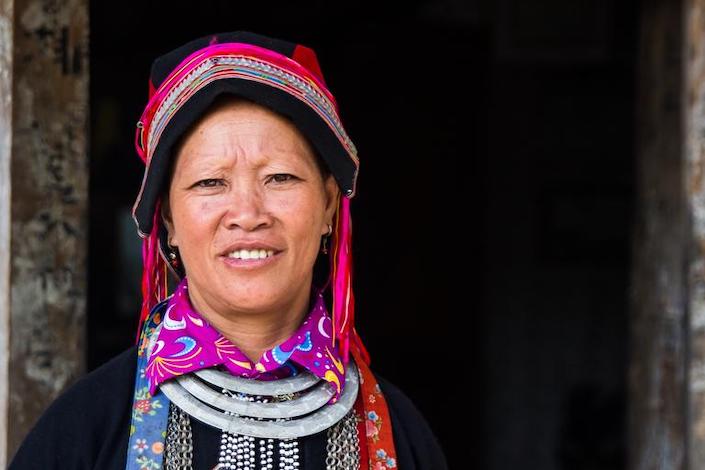
People from Prc's Dai ethnic minority grouping wearable vesture that incorporates many Southeast Asian elements.
Tibetan ethnic minority (藏族 Zàngzú)
Due to the harsh weather and barren plains of the loftier Tibetan plateau, many Tibetans employ real sheepskin, fur garments and leather shoes in lodge to protect themselves from the cold and harsh weather condition.
Due to the desperate weather condition changes throughout the solar day, layers are worn and taken off to be tied effectually the waist as the temperatures change.
In general, both men and women article of clothing long robes fabricated of wool, sheepskin, leather or cloth that are secured around the waist. Women sometimes wear elaborate headdresses usually made out of silvery, coral and turquoise for various special occasions and to demonstrate their age and marital condition.
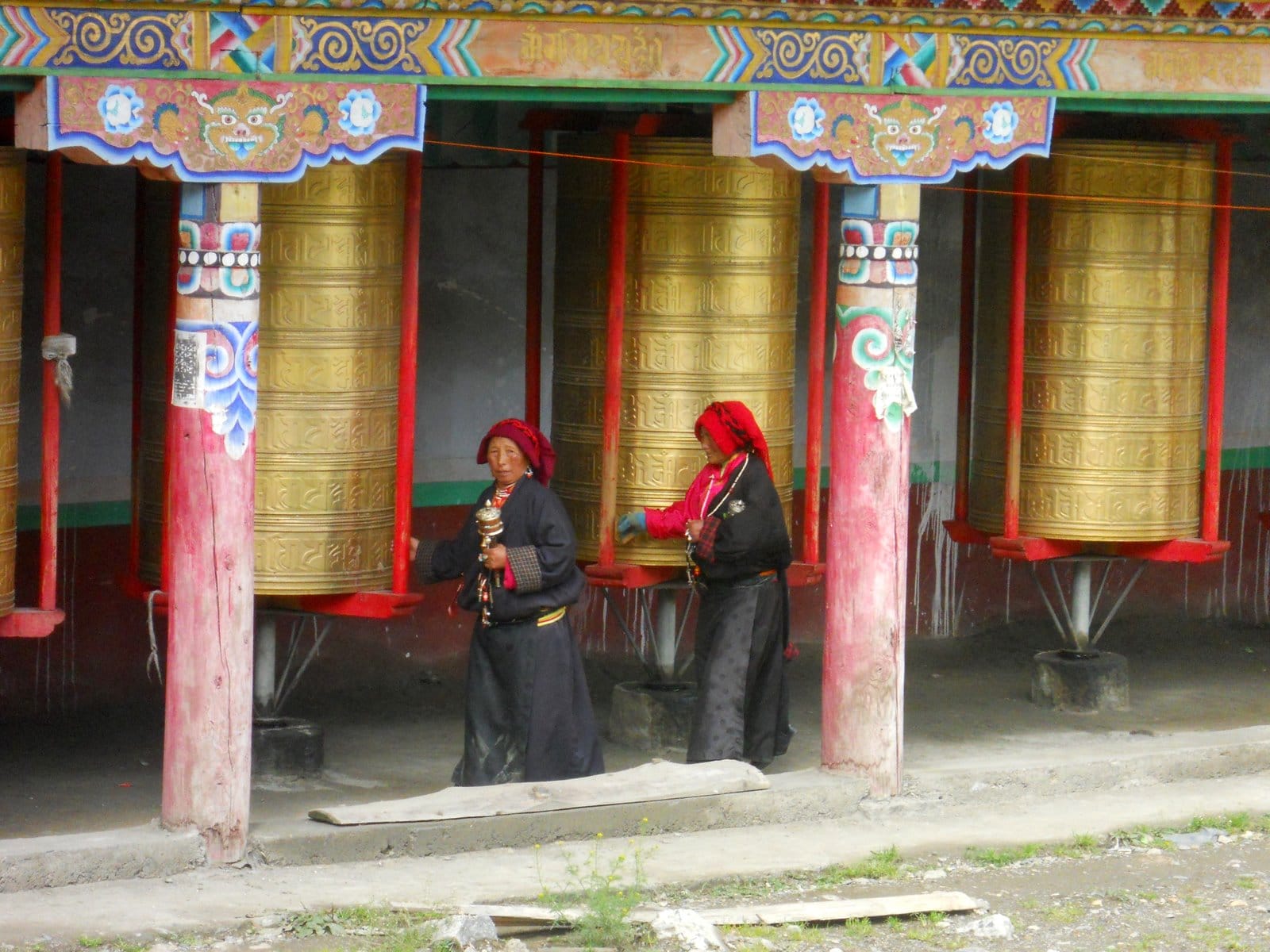
Modern Tibetan people often wearable long robes secured at the waste matter. Image credit: Anne Meredith.
Uyghur ethnic minority (维吾尔族 Wéiwú'ěrzú)
Uyghur wearable is deeply intertwined with Islamic culture and their proximity to the Silk Road. As a result, the culture of the Uyghurs incorporates aspects of the cultures of neighbouring countries such as Pakistan, Kazakhstan and Afghanistan.
Women traditionally wearable long-sleeved dresses decorated with silk embroidery. Golds, reds, and blacks are the most pop colors.
Xinjiang produces the majority of the globe's cotton fiber, then it is a widely used material in Uyghur clothing. The same holds truthful for satin and silk, and women usually use silk scarves as head coverings. Uyghur women tend to wear a lot of jewelry to compliment their outfits.
Men wear a long caftan with a long scarf tied at the waist and a "chapan," which is a woolen glaze worn during the colder winter months. Men also traditionally wear a doppa, which is a skull cap also worn past men in neighbouring Uzbekistan and Tajikistan.
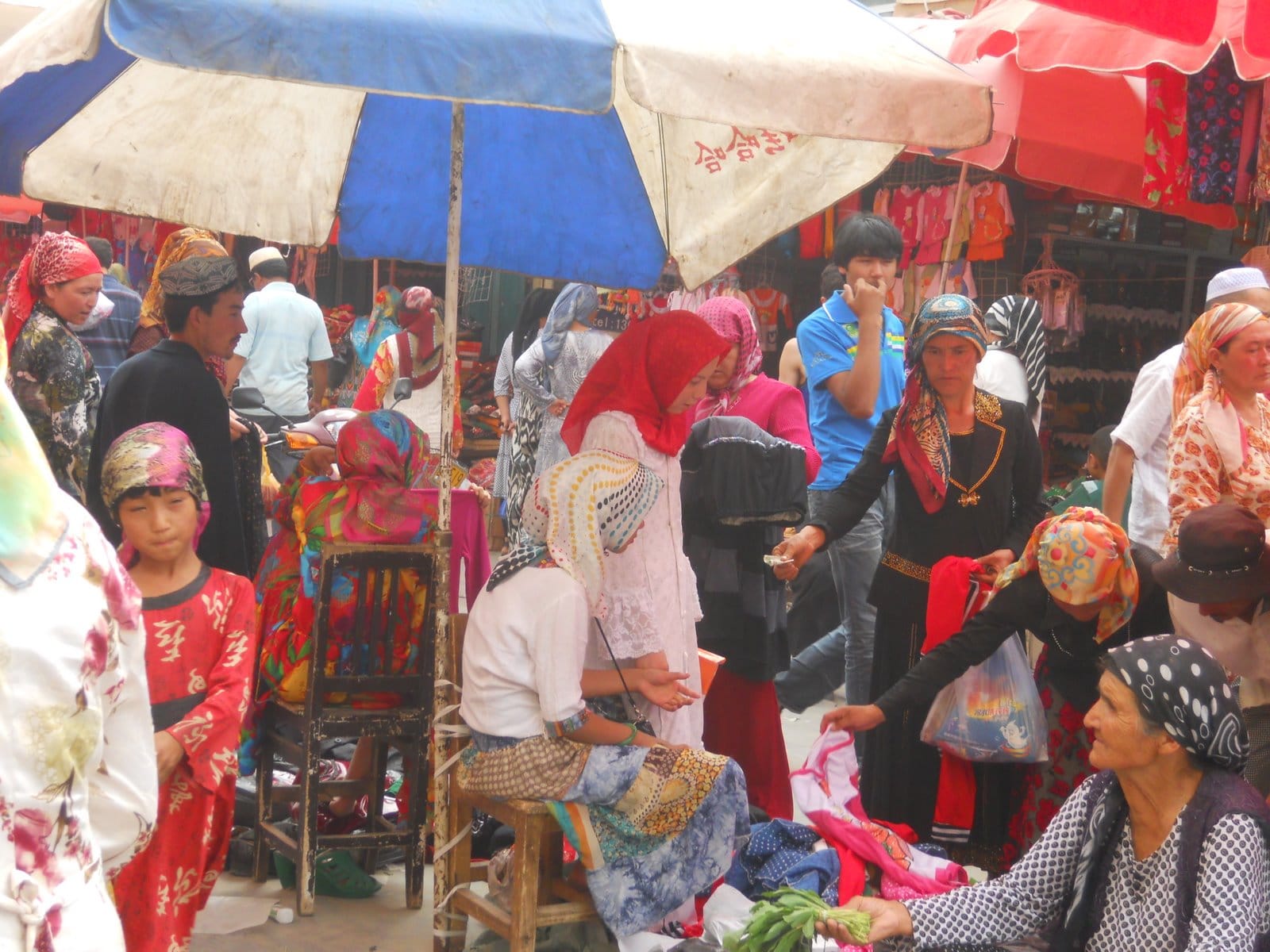
Uyghur women frequently embrace their heads with colorful scarves. Epitome credit: Anne Meredith.
Zhuang ethnic minority (壮族 Zhuàngzú)
The majority of the Zhuang people alive in Guangxi province. Their clothing is very evidently and largely consists of muted and bawdy colors such as brown, blackness and blue. The Zhuang are excellent craftspeople and take historically e'er self-spun, self-woven, self-sown their ain clothes.
Men usually wear a blackness tang suit with wide fitting trousers and a waist tie, sometimes paired with a turban depending on the weather.
Women generally wear a collarless jacket which is usually blueish and black, with slightly wider trousers, black turbans on their heads and aprons effectually their waists. Embroidery can exist plant on the cuffs and bottom of the placket (an opening or slit in a garment).
Their traditionally apparently outfits are usually paired with silver earrings, bracelets and decorative head accessories. Straw shoes are unremarkably used by those working in the fields.
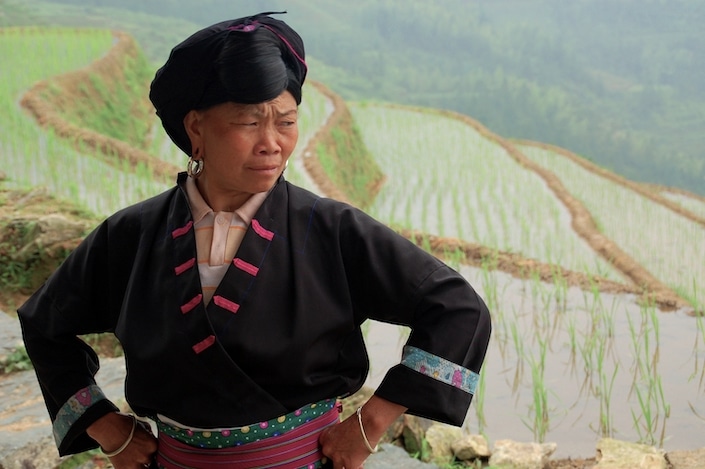
Women from the Zhuang ethnic minority grouping tend to wear dark-colored clothing with embroidered accents.
CLI regularly hosts trips to the Longji Rice Terraces for students enrolled in our Immersion Program , assuasive students to experience the alluring beauty and tranquility of Chinese hamlet life, whilst simultaneously learning about the Zhuang indigenous minority who are among the main inhabitants of Ping'an (Zhuang) Village in Longsheng.
Traditional clothes in modern China
In recent years, traditional Chinese clothing has become increasingly pop in modern China. This is particularly truthful amongst members of the younger generation.
A source of pride and cultural recognition
In recent years, there has been a renewed interest in traditional Chinese culture in Communist china, some of which can exist attributed to the rise of flow dramas.
More than and more Chinese youth abet the revival of traditional Chinese wearable (mainly 汉服 hànfú) and some accept even begun to habiliment these styles whilst engaging in everyday leisure activities.
Present, it is not uncommon to see a group of Chinese teenagers or young adults wearing traditional clothing while ordering a chimera tea and strolling around in the downtown areas of major cities. Many at present view traditional apparel as a source of national pride and a mode to showcase the beauty of Chinese history and civilisation.

Formal occasions
Traditional habiliment is also a popular choice for more formal occasions and celebratory events. For case, many women choose to wear the qipao for formal dinners and Chinese New year galas and qipaos are also sometimes used as professional person uniforms for workers in the high end hospitality industry.
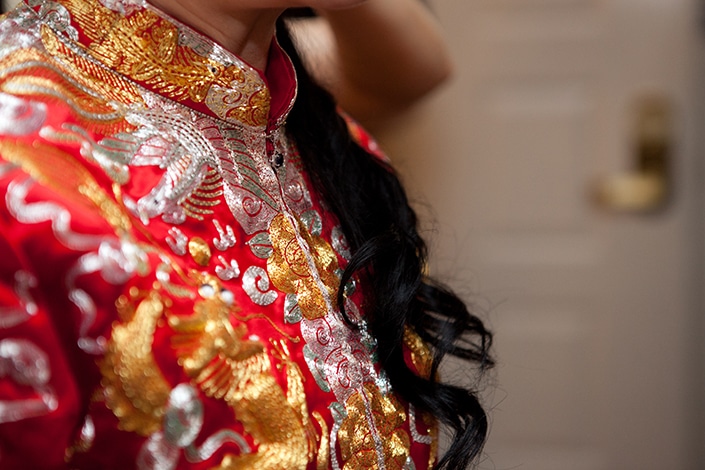
Modernized qipaos are popular uniforms amongst high-end eating place workers in Prc today.
Haute Couture
Many creative artists and designers working in the earth of haute couture take created designs that fuse diverse international styles, using traditional Chinese clothing as inspiration and completely redefining the notion of "made in China."
Some famous haute couture designers who include traditional Chinese elements in their designs are Laurence Xu , Guo Pei , Huishan Zhang and Wang Chen Tsai-Hsia (AKA the Chanel of Taiwan).
Fifty-fifty western fashion houses such as Dior and Elie Saab have created collections entirely inspired and influenced by Chinese embroidery and imperial designs.
The new face of Chinese fashion?
Despite the ever changing trends within the way industry, more people in Cathay are looking back to the traditional dress of their ancestors in order to honor their heritage and bring back a affect of ancient amuse to our modern, digitalized world.
No matter which dynasty y'all consider, each has left its unique mark on traditional attire and continues to do so even in the 21st century.
They say fashion repeats itself, just rather than following the typical 25-yr repetitive cycles used in the fashion manufacture today, possibly unearthing and revamping trends from hundreds of years ago is the new way forward.
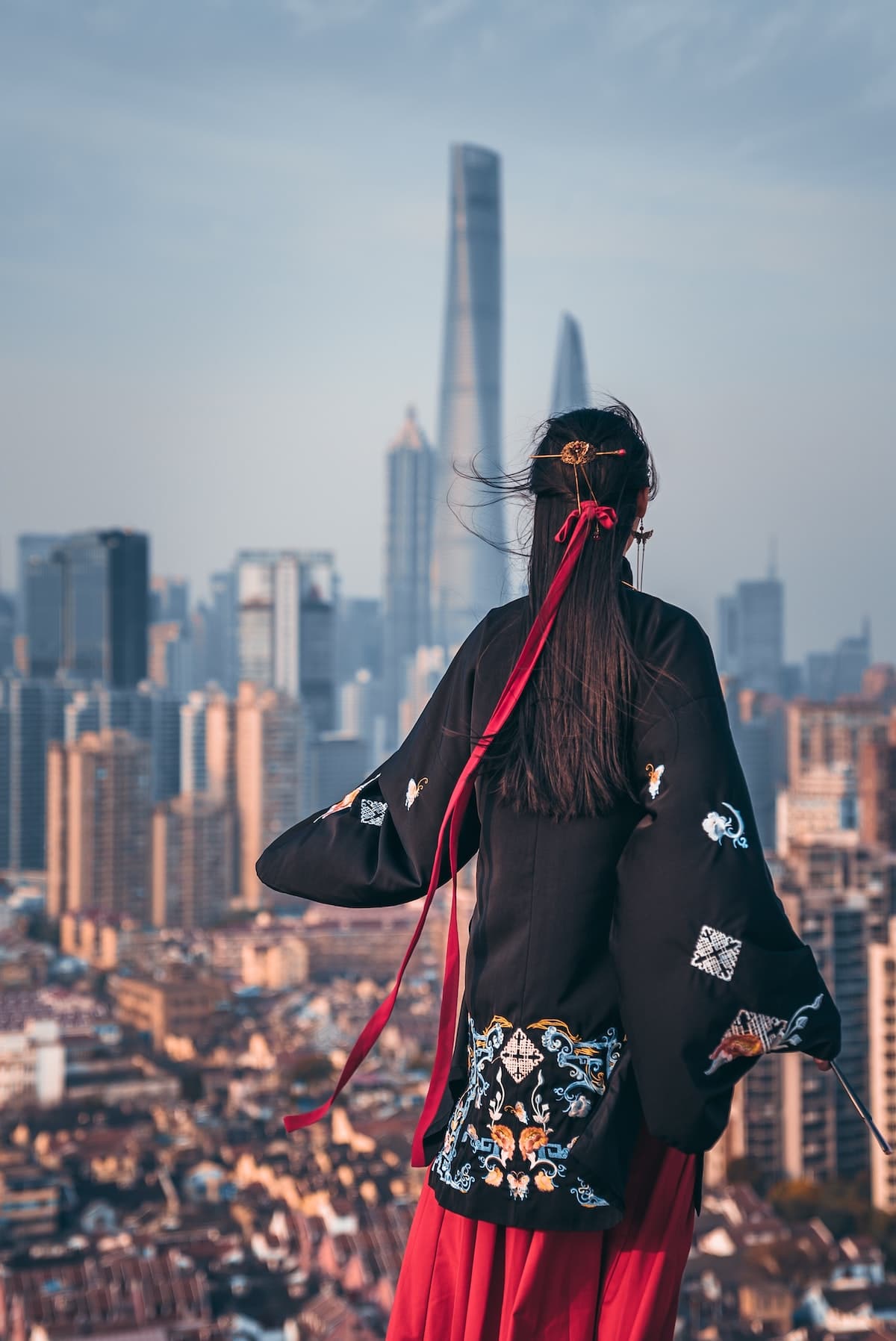
Traditional Chinese fashion is currently experiencing a resurgence.
Traditional Chinese clothing vocabulary
| Chinese | Pinyin | English language |
|---|---|---|
| 传统服饰 | chuántǒng fúshì | traditional clothing |
| 少数民族 | shǎoshù mínzú | indigenous minorities |
| 历史 | lìshǐ | history |
| 朝代 | cháodài | dynasty |
| 着装要求 | zhuózhuāng yāoqiú | apparel code |
| 长袍 | chángpáo | robe |
| 发型/发式 | fǎxíng/fǎshì | hairstyle |
| 辫子 | biànzi | queue (braid style) |
| 丝绸 | sīchóu | silk |
| 棉 | mián | cotton |
| 刺绣 | cìxiù | embroidery |
| 贸易 | màoyì | trade |
| 外国影响 | wàiguó yǐngxiǎng | foreign influence |
| 社会阶层 | shèhuì jiēcéng | social course |
| 高级时装 | gāojí shízhuāng | haute couture |
| 复兴 | fùxīng | revival |
| 民族自豪感 | mínzú zìháogǎn | national pride |



0 Response to "Evolution of China Fashion Chinese Clothes in the 1900s"
Post a Comment